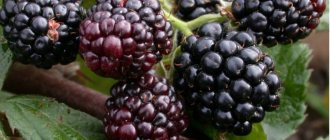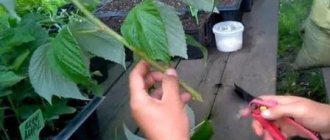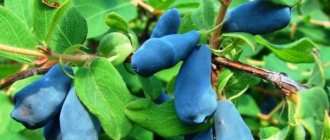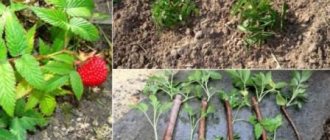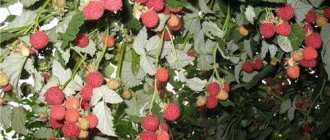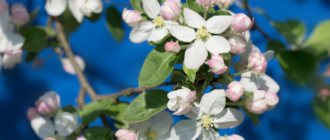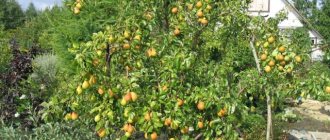History of variety development
Raspberries of the Maroseyka variety are the result of the activities of the Institute of Horticulture (Moscow). The work was carried out under the guidance of Professor V.V. Kichina back in the 70s of the last century. The variety is taken as a basis from Scottish selection.
The emphasis is on producing larger and sweeter berries, as well as increasing winter hardiness and disease resistance. At that time, it was the first thornless raspberry on the Russian market. But even now this variety is of interest to many, despite the great abundance of other products.
Familiarize yourself with the features of spring pruning of raspberries according to Sobolev.
Characteristics, description
The hallmark of the culture is the absence of thorns and large fruit.
In addition, the plant has a number of other characteristics:
- the shoots reach a height of about one and a half meters and are covered with a waxy coating;
- mature bushes are spreading;
- the leaves are large, warty along the edges, rich green;
- a large number of replacement shoots are formed (up to 10 pcs.) and about 5 root shoots;
- the fruiting branches are powerful and consist of several orders of branching (from 2 to 5). On average, up to 20 berries are formed on the clusters;
- winter hardiness is average, withstands frosts down to -25°C;
- The fruiting period is up to 10–15 years.
Maroseyka fruits:
- berries are cone-shaped, elongated and large (from 4 to 12 g);
- light red color;
- covered with a faint bluish coating;
- seeds are small and few in number;
- the pulp is dense, juicy, sweet, with slight sourness and a raspberry aroma (reminiscent of wild berries);
- are not subject to shedding after ripening, but are easily separated from the stalk;
- a large percentage of double fruits.
Reviews
I have Maroseyka. The berry does not crumble, is tasty, with a real raspberry aroma, like small forest raspberries. Care is not labor-intensive, but the main work - watering, fertilizing, garter - should not be ignored.
Our Maroseyka has been growing for five years. We brought cuttings from the south of the country; we couldn’t find this variety in the Urals. The raspberry completely justified all the worries! The berries ripen from the end of June to the end of August, the family spends the whole summer with berries. The fruits are very large and have a special taste, as if from childhood. It is not difficult to grow. Once every two years we fertilize with Baikal-Em, mulch the ground with humus, and pinch the tops. Winters well under snow without shelter.
Maroseyka is one of the most successful varieties of summer raspberries, which produces large yields of large, very tasty berries, with simple agricultural technology, in different climatic conditions.
Advantages and disadvantages
- Culture is characterized by numerous positive aspects:
- absence of thorns on the stems, which simplifies harvesting;
- tasty and large fruits;
- high yield (from 4 to 6 kg per bush);
- the variety is not remontant, but sometimes produces a second harvest;
- ease of care;
- good frost resistance (-25°C);
- suitability of products for transportation and processing (drying, freezing, canning);
- ease of reproduction, which is facilitated by the numerous formation of shoots (which is more likely to be a disadvantage), as well as the good survival rate of seedlings;
- resistance to major raspberry diseases.
- However, Maroseyka also has some disadvantages:
- large volume and spreading of the bush, requiring support and tying;
- excess growth;
- superficial root system;
- the need for formative pruning of the bush;
- in the northern regions shelter is required for the winter;
- due to genetic instability, berries are crushed after a 10-year fruiting period.
Did you know? Bees increase raspberry yield by 60%. Rain does not interfere with collecting nectar from raspberry flowers growing downwards.
Drought resistance, frost resistance
The plant's resistance to drought is not very high, since the root system is located close to the soil surface. For this reason, additional irrigation is necessary. This circumstance creates additional difficulties during large-scale cultivation.
The variety is characterized by average frost resistance, which is at the level of -25 ° C (without shelter). Therefore, in the South, the crop can winter without shelter.
In the middle and northern regions, in addition to bending to the ground, the bushes need to be insulated with protective material. This is especially true for those regions where there is little snowfall, but there are severe frosts and cold winds.
Did you know? From 1 hectare of wild raspberries, up to 70 kg of honey is obtained, and from the same volume of garden bushes - only 50 kg.
Productivity and fruiting
Features of Maroseyka fruiting:
- In the second year after planting, the first crop ripens. Fruiting begins in full force already in the 3rd year;
- mid-early variety;
- in the southern regions, fruiting begins already in mid-June, and in the rest - in early to mid-July;
- the bulk of the fruit is collected in 4-5 times;
- berry picking period - about a month;
- The variety is not remontant, so it bears fruit once a year, but sometimes there are repeated harvests.
The yield is high and amounts to 4 kg per bush. Subject to intensive agrotechnical measures, this figure can be increased to 6 kg or more. The productivity of 1 hundred square meters is in the range of 180–200 kg. The variety is not very suitable for industrial cultivation.
Video: large-fruited raspberries of the Maroseyka variety
Advantages and disadvantages
The plant has quite a few advantages:
- high yield parameters;
- pleasant taste of fruits;
- large berries;
- universal purpose of fruits;
- unpretentiousness to growing conditions;
- absence of thorns on the shoots;
- frost resistance up to -30 degrees.
At the same time, culture also has certain disadvantages. The plant has an impressive size, so it needs a garter. With prolonged cultivation in the same place, the fruits gradually become smaller. When growing a crop in regions with a harsh climate, it must be covered for the winter.
Important! A significant disadvantage of the crop is the need for systematic watering. If you don't irrigate the bushes on time, they die.
Landing Features
Taking into account the characteristics of planting, growth and fruiting, each crop requires a specific approach.
Deadlines
Planting work can be carried out at your discretion, both in spring and autumn.
Depending on the planting period, some features are taken into account:
- When planting in spring, the site must be prepared in the fall. The event includes digging the soil to a depth of about 30 cm, as well as applying 40 g of potash fertilizers and superphosphate per 1 m²;
- Experts consider the optimal time for planting in spring to be April, when warm weather sets in and the soil warms up to +15°C;
- when planting raspberries in autumn, the preparatory work is the same as for spring planting, but they are carried out 30 days before the proposed work;
- Bushes are planted a month and a half before the first frost (October), so that the seedlings have time to take root and prepare for winter.
Read how to plant raspberries in summer and autumn.
Choosing a suitable location
When deciding where to grow Maroseyka, you should know that this raspberry needs:
- Well-lit areas. The sun's rays must fall on the site all day, otherwise the branches will stretch and become brittle, and the berries will acquire a sour taste.
- If the raspberry tree is still located in partial shade, good supports should be prepared so that it is possible to tie up elongated branches and thereby prevent them from breaking.
- The site should not be subject to stagnation of melt or rain water, so it should be a flat or elevated area. But too elevated areas are not suitable for the reason that the root system (close to the soil surface) will dry out.
- Raspberries also do not like cold drafts, so it will be good if it is protected from the north winds by a building or a fence.
- Raspberries are comfortable in neutral soils, so if the soil is acidic, then it is necessary to add dolomite flour or lime (150–200 g/m²).
Selection and preparation of planting material
For successful further cultivation of raspberries, you first need to choose the right seedlings and prepare them for planting:
- bushes must have well-developed roots; it is undesirable for them to be dried out, rotten or damaged;
- in the aerial part it is desirable to have at least two lignified powerful shoots;
- when the top layer of bark is lifted, there should be a green layer underneath it - this indicates the good condition of the shoots;
- the bushes need to be cut to 45 cm (so that 4-5 buds remain), and the roots should be placed in water for a couple of hours, and then dipped into a clay mash;
- The sections are sprinkled with ash or activated carbon.
Planting scheme
When planting raspberry seedlings, adhere to several simple rules:
- A hole is dug slightly larger than the size of the rhizome. Its depth is 35–40 cm.
- The bottom is covered with a drainage layer of crushed stone or broken brick.
- The main substrate used is a peat-humus mixture (2:1) and sand (1 part). It can also be chernozem and rotted straw or sawdust in equal parts.
- To prevent overcrowding of plantings and improve the care of raspberries, maintain a distance between bushes of 70–100 cm, and between rows - 1.5-2 m.
Important! To prevent raspberry bushes from growing uncontrollably throughout the area, strips of iron or slate can be dug into the ground around the perimeter.
The landing algorithm follows the standard scheme:
- Dig a hole of the required size, approximately 0.5 × 0.4 × 0.4 m.
- Cover the bottom with drainage.
- Make a mound in the center of the hole from the main soil mixture.
- Place the roots of the seedling on a hill and spread it evenly.
- Cover the rhizome with soil (the replacement bud should be just below the soil level) and lightly compact it.
- A shallow hole is made around the perimeter into which water is poured.
- After absorbing moisture, the soil around the bush is mulched with straw, humus or sawdust.
Preparing the site, soil and seedlings
Before planting a sprout, you will need to choose the optimal location, prepare the site and select a high-quality seedling. It is recommended to follow the basic rules:
- Location - this variety of fruit crop loves an abundance of sunlight, but also tolerates living in the shade. Due to the fact that the bush tends to stretch upward, it is worth thinking about supports until the lashes reach their maximum size. Therefore, it is necessary to connect a support, an arch, or dig stakes nearby. Otherwise, the branches will stretch, become brittle and break easily.
- Neighborhood - the raspberry tree should be located so that neighboring plants or fruit trees. And also the buildings did not cast a shadow on the plant, then the volume of the harvest may decrease or be small in size, as well as sour in taste.
- Soil – it is recommended to choose a fertile substrate. If this is not available, then it is better to pre-feed the soil with nutrients of both organic and mineral types. In addition, it is worth making sure that there is good drainage under the roots of the plant.
You should avoid places where melt water collects, moisture accumulates, and where groundwater lies close to the surface. Although Maroseyka loves an abundance of moisture, it does not tolerate stagnation. Although the plant is considered a shrub with increased immunity, it is worth choosing a location so that the raspberry tree is on the south side, sheltered from the piercing north wind and cold drafts by a fence or building.
Before planting, you need to check the acidity of the soil - it should be neutral. If there is an increased volume of soil with an acidic environment on a personal plot, you will need to introduce 0.15-0.3 kg of dolomite flour, lime or cement dust per 1 m2. This is necessary to bring the pH level to normal.
Read also: Raspberry Laszka (Lyachka, Lyashka, Lachka, Lashka): description of the variety, photo
The plant can be planted both in autumn and spring. In the first case, it is recommended to place the sprouts in a permanent place of residence 30-45 days before the onset of cold weather. This is required so that the sprout has time to fully take root in a new place and prepare for wintering by releasing adventitious rhizomes. In spring, it is recommended to plant only after the onset of warm days, when the snow has completely melted.
You can learn more about what Maroseyka raspberries look like from the video:
Depending on the period in which the seedling will be planted, it is recommended to plan preparatory work. If rooting is carried out in the spring, then soil preparation will be required in the fall. If the plant is planned to be rooted in October, then it is worth tidying up the area within 1 month. First of all, in the selected area it is necessary to remove all debris, stones, and parts of the rhizomes of other plants. The territory is dug up using a shovel. For raspberries, the ideal amount of soil cultivation is 30 cm. In this case, the soil is immediately fertilized. Potassium substances and superphosphates are added to it at 40 and 50 g. respectively.
If planting is carried out in the fall, it is recommended to first dig up the soil along with organic matter: chicken droppings, humus, compost or mullein. You can also add wood ash. The last step before planting the sprout is to select a high-quality seedling. When purchasing, it is recommended to carefully examine the root system and above-ground parts. If there are damaged areas or rot, then such sprouts should not be purchased. It is necessary to give preference to seedlings with a well-developed root system.
It is necessary to check the sprout for freshness - lift the upper part of the bark with your fingernail. If it is green, then the seedling is good; if it is brown, then the plant is dead. Before planting, the selected seedling should also be prepared: inspect for the presence of dry tips on the rhizomes. All dry areas are removed with a sharp garden tool, and the top is sprinkled with crushed activated carbon or wood ash. Afterwards, it is recommended to place the roots in liquid for a couple of hours, and then move the seedling into a clay mash. Only after this the plant is placed in a prepared hole in the ground.
Rules of care
Agrotechnical measures for caring for Maroseyka are not much different from standard care for any raspberries:
- In hot weather, plants require abundant watering so that the soil is saturated with moisture to a depth of 30–40 cm. In rainy weather, watering is reduced and possibly stopped altogether. An alternative irrigation option can be drip irrigation. Mulch also prevents rapid loss of moisture.
- An important technique when growing raspberries is mulching, because this crop prefers porous and moist soils. A good option is to cover the ground in the raspberry patch with newspapers, which are sprinkled with any mulch on top (straw, shavings, grass clippings and even kitchen waste). To mulch and further enrich the soil with microelements, green manure (phacelia, mustard, millet, oats) is sown between rows in the fall, which are mowed in the spring and used for mulch.
- Even with constant application of mulch, it will not be superfluous to use fertilizers. In the spring, you can use an infusion of bird droppings for this (1 kg/10 l leave for 7 days), diluted in a ratio of 1:10. In the fall, you can use a complex infusion. It is prepared from grass (2/3 of the container), a glass of ash, a handful of granulated manure or vermicompost and 1.5 tbsp. sugar or jam. The mixture ferments for 10 days, is diluted 1:10 and used for irrigation.
- Maroseyka has a tendency to form numerous shoots and grow, so it requires regular pruning. In the spring, the shoots are cut out and no more than 5-6 replacement shoots are left. In the fall, remove all weak, dry and young shoots that will not survive the winter.
- To make the bush more voluminous, it is practiced to pinch the growing point at a height of 1 m. This technique is explained by the formation of new branches from side buds, which provide a better harvest.
- It is necessary to install a trellis and tie raspberry branches to it. This structure will hold the stems and provide access to the plants for care and picking berries. A single-sheet trellis with 2 rows of wire or thick fishing line is suitable for this purpose.
Raspberry "Maroseyka": planting and care
As mentioned above, the “Maroseyka” variety is quite unpretentious, but its cultivation still has its own nuances:
- Landing place. Raspberries of this variety love sunlight, but you can plant bushes in partial shade. Since the plant is quite tall, you should consider the method of tying it and build a support or arch. It is better to choose fertile soil or to fertilize the soil well if it is poor.
- Landing. You can plant new bushes in both spring and autumn. Most often, gardeners use the method of dividing the bush, since “Maroseyka” produces a lot of shoots, this is easy to do. Raspberries are planted in rows, leaving at least 70-80 cm of space between plants, because the bushes are spreading and powerful. The most common planting method is used. At a height of 100-120 cm, a wire is pulled to tie long shoots.
- Fertilizer. During planting, nitrogen-mineral fertilizers are placed in the dug holes or rotted organic matter (cow manure, bird droppings, compost) is used. Every year during the flowering period, raspberries are fertilized with a complex consisting of nitrogen, phosphorus and potassium. In the fall, before wintering, raspberries are fertilized with organic matter. Just don’t use fresh manure, it can burn the plants and their roots; it’s better to use humus.
- Care. Caring for Maroseyka raspberries is easy. After planting, the soil around the plants is regularly loosened so that the roots are ventilated and receive a sufficient amount of oxygen. Weeds between rows should be pulled out or weeded. Water the raspberries as the soil dries out.
- Trimming. Maroseyka shoots need to be trimmed both in spring and autumn, but this should be done in moderation. In the fall, the gardener must cut out branches that are too young and weak, because they will not be able to overwinter normally and will freeze. You will also have to remove diseased or dry shoots. You can shorten the raspberry stems a little, especially if you plan to cover them for the winter. In spring, the bushes are thinned out by cutting out the shoots. There should be no more than six shoots left in each bush. If it is necessary to branch a raspberry, pinch it at a height of about a meter: the bush will be more powerful and will produce a larger harvest.
- Shelter. As already mentioned, “Maroseyka” tolerates cold well, but frosts greater than -30 degrees are destructive for it. Therefore, in the northern regions, gardeners will have to take care of covering the bushes for the winter. “Maroseyka” is covered no later than the last days of September, since then the raspberry shoots become too brittle and cannot be laid properly. First, the branches are trimmed, unnecessary shoots are removed, then the bush is tied and laid on its side. You can cover “Maroseyka” with spunbond, straw, sawdust, spruce branches or any other material. If the winters in the region are snowy, just throw snow on the pinned raspberry - it will warm the plant better than any artificial shelter.
Attention! After severe frosts, “Maroseyka” may not freeze out, but the raspberry yield after such stress will noticeably decrease.
This is all the care for the Maroseyka variety. These raspberries very rarely get sick, and there is no need to treat them for pests, which significantly reduces the gardener’s time and money.
Harvesting and storage
There are some features in harvesting and storing the Maroseyka crop:
- the fruits ripen gradually over 1 month, so they are collected in 3-4 stages;
- to increase the shelf life and transportability of berries, it is recommended to collect them together with the stalk;
- It is advisable to sell products in small volumes, and so that the place of sale is located near the place of collection;
- the variety is no longer suitable for sale, but for personal consumption. The berries can be frozen or used to make preserves, jams, compotes and desserts.
Important! It is recommended to grow Maroseyka raspberries in one place for no more than 8 years.
Weak sides
- Quite spreading shoots; installation of a trellis or supports is required. Plus, the bush grows widely, this must be taken into account when choosing a planting scheme.
- Maroseyka produces quite a lot of shoots per season, and the laterals have up to 4 orders of branching. Therefore, regular cutting of excess stems and branches that thicken the bush is required.
- There is no uniformity of fruits, a large percentage of double, slightly deformed and twisted berries.
- Average (up to -25°C) frost resistance.
- Transportability and shelf life are at an average level, especially for large fruits. It is advisable to tear it off together with the stalk. Transportation over long distances is problematic.
- When overripe, the berries are only suitable for processing and making wine.
The final conclusion is, of course, up to you. It’s even better to draw all the conclusions by planting the variety and observing it for 2-3 years. But I want to make a reservation right away - I’m sure that Maroseyka will definitely not disappoint. This is indeed a very worthy raspberry, but mainly for amateur cultivation in the country or garden.
Author: Maxim Zarechny.
Preparing for winter
A cold climate with frosts below -25°C is an indication for insulating Maroseyka raspberries for the winter. It is advisable to carry out the work at the end of September, since during this period the stems are quite flexible and do not break.
Insulation consists of several sequential actions:
- The branches are collected into a bundle and tied.
- The bundle is tilted to one side and the top is tied to the base.
- The stems are carefully bent to the ground and secured with metal hooks or staples.
- The top is covered with spunbond, agrofibre or other suitable material, or simply sprinkled with soil.
Many gardeners advise making a shelter from leaves or straw, but this is dangerous due to the appearance of wintering mice in this place, which receive both warm shelter and food.
The main mistakes made when growing this variety
When growing, it is important to adhere to the necessary rules of agricultural technology. Common mistakes when cultivating raspberries:
- Failure to maintain the distance between bushes. The planting becomes overgrown, shaded, the bushes lack nutrients, the berries become sour, and the yield drops.
- Not pruning bushes. The crop thickens, in addition to yield, the plant is susceptible to diseases.
- The plant is not covered for the winter. The raspberries may freeze or the yield will decrease.
If you follow simple rules of agricultural technology, the plant will delight you with a bountiful harvest.
Reproduction methods
Raspberries produce abundant shoots, so growing them is not difficult.
Important! When planted in summer, raspberry seedlings have time to take root well and prepare for winter.
There are several options for propagating raspberries:
- offspring growing next to the mother bush, when they reach a height of 15 cm, can be dug up from an adult plant along with the root. This can be done at any time, but the optimal rise occurs in June or July;
- From the old bush with a shovel, you can separate the younger part with the roots along with the stems up to 1 cm in diameter (they are shortened to 25 cm) and transplant it to a new place. It is better to hold such an event in the spring;
- a more complex method is cuttings. In June, cuttings (10–12 cm) are cut from 2-3 year old offspring and soaked for several hours in a root formation stimulator. Next, they are placed in containers with a peat-sand mixture and covered with film. In the fall they are planted in a permanent place.
Diseases and pests
Maroseyka is resistant to many diseases, partly due to a waxy coating that protects the plant from pathogenic microorganisms. But sometimes, if agricultural cultivation practices are violated, or due to unfavorable weather conditions, some diseases or pests may still appear:
- powdery mildew may appear , characterized by the appearance of a white coating. To combat the disease, fungicides “Topaz”, “Skor”, “Fundazol” are used, according to the instructions.
- With insufficient watering, grayish spots with a purple border may form on all raspberry organs. This is anthracnose . For treatment, spraying with 1% Bordeaux mixture is used at intervals of 10 days.
- The appearance of small orange tubercles indicates rust . Such bushes must be destroyed. For prevention, treatments are carried out with 1% Bordeaux mixture.
- Yellowing of leaves during fruiting may be a sign of chlorosis . To prevent the spread of this disease, sucking insects are combated by spraying with a 3% Nitrafen solution in the spring before the buds open.
To prevent infection with diseases during spring spraying, fungicides Antrakol, Previkur Energy, Skor and others are used. An alternative would be to use copper sulfate. When infested by thrips, raspberry beetles or other insects, Aktara, Detoil, Provado, and Envidor are effective.
Read how to spray raspberries in the spring against pests and diseases.
To prevent diseases and the appearance of pests, you need to remove weeds in a timely manner, apply fertilizing, do not over-moisten the soil and adhere to basic agricultural practices.
There are many positive reviews about the Maroseyka raspberry regarding its yield and the size of its delicious berries. But its cultivation in large volumes is not recommended. It is more suitable for amateur cultivation. In this case, the variety is unlikely to disappoint.


